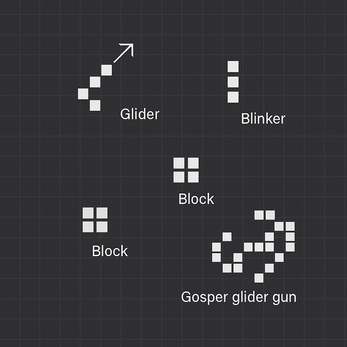Game of Life
Conway’s Game of Life — Technical Overview
Definition
Conway’s Game of Life is a two-dimensional cellular automaton introduced by mathematician John H. Conway in 1970. It is a zero-player game: once the initial state is set, the board evolves deterministically with no further input.
Core Concepts
| Item | Details |
|---|---|
| Universe | Infinite orthogonal grid of square cells (practically, finite with wrap or hard edges). |
| Cell State | Each cell is either alive (1) or dead (0). |
| Neighbourhood | The eight orthogonally and diagonally adjacent cells (Moore neighbourhood). |
| Generation | One simultaneous update of every cell based on the rules below. |
Transition Rules (per generation)
-
Under-population Any live cell with fewer than two live neighbours dies.
-
Survival Any live cell with two or three live neighbours lives on.
-
Over-population Any live cell with more than three live neighbours dies.
-
Reproduction Any dead cell with exactly three live neighbours becomes a live cell.
All updates are applied simultaneously, producing the next generation.
Behavioural Classes
-
Still lifes – static patterns (e.g., Block, Beehive).
-
Oscillators – repeat after n generations (e.g., Blinker, Toad, Pulsar).
-
Spaceships – translate across the grid while repeating (e.g., Glider, Light-weight spaceship).
-
Methuselahs – small seeds that generate long, chaotic evolutions before stabilising (e.g., R-pentomino).
-
Guns – emit an endless stream of spaceships (e.g., Gosper Glider Gun).
Computational Significance
-
Proven Turing-complete – can emulate any Turing machine given a suitable pattern arrangement.
-
Demonstrates how complexity can emerge from extremely simple rules.
-
Widely used in theoretical computer science, complexity studies, and algorithm education.
Common Implementation Notes
| Aspect | Recommendation |
|---|---|
| Data structure | 2-D array / bit-array (+ double buffer) or sparse hash-set for large sparse worlds. |
| Boundary handling | Wrap-around (toroidal), fixed dead border, or dynamic expansion. |
| Rendering | Direct pixel/rect draw, texture blitting, or shader-based visualization for speed. |
| Interactivity | Step, run/pause, reset, pattern insertion, speed and zoom controls. |
| Published | 22 days ago |
| Status | Released |
| Platforms | HTML5 |
| Author | procrastinationGaming |
| Genre | Educational |
| Made with | Godot |

Leave a comment
Log in with itch.io to leave a comment.